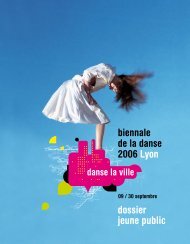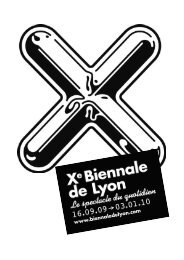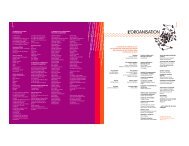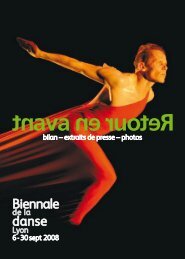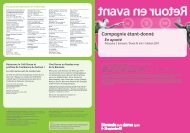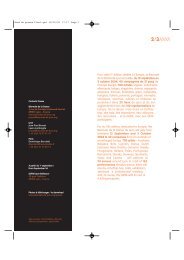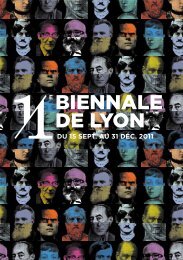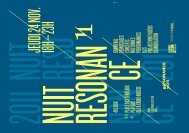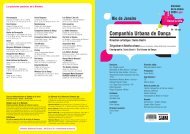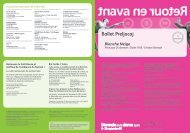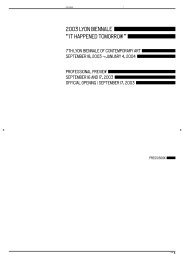Retour en Avant / Past Forward Biennale de la Danse Lyon - France
Retour en Avant / Past Forward Biennale de la Danse Lyon - France
Retour en Avant / Past Forward Biennale de la Danse Lyon - France
- No tags were found...
Create successful ePaper yourself
Turn your PDF publications into a flip-book with our unique Google optimized e-Paper software.
Agwa / créationA <strong>la</strong> source d’Agwa, une r<strong>en</strong>contre : celle<strong>de</strong> Mourad Merzouki avec <strong>la</strong> CompanhiaUrbana <strong>de</strong> Dança lors <strong>de</strong> <strong>la</strong> Bi<strong>en</strong>nale <strong>de</strong><strong>la</strong> <strong>Danse</strong> <strong>de</strong> <strong>Lyon</strong> <strong>en</strong> 2006. Une r<strong>en</strong>contre<strong>en</strong> forme <strong>de</strong> reflet. Originaires du Brésil,les 10 danseurs <strong>de</strong> <strong>la</strong> compagnie ont <strong>de</strong>shistoires aux cours sinueux qui plong<strong>en</strong>tleurs racines dans les fave<strong>la</strong>s et qui fontressurgir <strong>de</strong>s souv<strong>en</strong>irs <strong>de</strong> <strong>la</strong> même eau auchorégraphe <strong>de</strong> Käfig. Ayant grandi dans<strong>la</strong> marginalité, ils ont tous puisé dans leurpassion pour <strong>la</strong> danse <strong>la</strong> rage <strong>de</strong> s’<strong>en</strong> sortiret d’aller vers l’autre. Une r<strong>en</strong>contre à <strong>la</strong>conflu<strong>en</strong>ce <strong>de</strong> plusieurs univers. Encadrés etmis <strong>en</strong> scène par Sonia Destri, leur chorégrapheattitrée, les danseurs <strong>de</strong> <strong>la</strong> CompanhiaUrbana <strong>de</strong> Dança dilu<strong>en</strong>t et mé<strong>la</strong>ng<strong>en</strong>tsans aucun complexe hip-hop, capoeira,samba, musique électronique et bossa novapour faire émerger une danse aux acrobatiesépoustouf<strong>la</strong>ntes, bourrée d’énergie etd’inv<strong>en</strong>tion… Dans <strong>la</strong> même veine que Käfigqui s’abreuve à <strong>de</strong> multiples courants chorégraphiqueset artistiques pour faire jaillirson propre mo<strong>de</strong> d’expression. Bref, uner<strong>en</strong>contre qui coule <strong>de</strong> source et débouche<strong>de</strong>ux ans plus tard sur un spectacle communp<strong>la</strong>cé sous le signe <strong>de</strong> l’eau (« agoa » <strong>en</strong>portugais), à <strong>la</strong> fois composant ess<strong>en</strong>tiel d<strong>en</strong>otre corps, ressource naturelle précieuse,vitale même, que l’on se doit d’économiseret <strong>de</strong> préserver et symbole <strong>de</strong> r<strong>en</strong>ouveau.Chorégraphiée par Mourad Merzouki, Agwaest imprégnée <strong>de</strong> ce triple <strong>en</strong>jeu. Sur scène,les 10 danseurs <strong>de</strong> <strong>la</strong> Companhia Urbana <strong>de</strong>Dança tourbillonneront autour d’une fontaineoù ils se désaltèreront régulièrem<strong>en</strong>tjusqu’à ce que l’eau vi<strong>en</strong>ne à manquer…Suite Funk Carioca e suburbana /créationSuite Funk, sous titrée Carioca e suburbana,est une pièce librem<strong>en</strong>t inspirée <strong>de</strong> <strong>la</strong> culture<strong>de</strong>s fave<strong>la</strong>s et <strong>de</strong> leur fameux bal funk, quiréunit chaque fin <strong>de</strong> semaine <strong>de</strong>s dizaines <strong>de</strong>milliers <strong>de</strong> jeunes cariocas. Un spectacle <strong>de</strong>Sonia Destri <strong>en</strong> cours <strong>de</strong> création.Comm<strong>en</strong>t le passé peut-il définir l’av<strong>en</strong>ir ?Les id<strong>en</strong>tités sont construites sur les mémoires<strong>de</strong> chacun, sur les histoires <strong>de</strong> chaque individu <strong>en</strong>particulier et du groupe <strong>en</strong> général. Nous sommes<strong>de</strong> Rio <strong>de</strong> Janeiro, <strong>de</strong>s <strong>de</strong>sc<strong>en</strong>dants <strong>de</strong>s Africains, <strong>de</strong>spersonnes nées <strong>en</strong> Amérique et issues pour <strong>la</strong> plupart<strong>de</strong> l’immigration. Nous sommes donc jeunes sur cettep<strong>la</strong>nète <strong>en</strong> mouvem<strong>en</strong>t. Nos chemins et nos dansesreflèt<strong>en</strong>t ce que nous étions, ce que nous sommes et ils<strong>de</strong>ssin<strong>en</strong>t notre prés<strong>en</strong>t et influ<strong>en</strong>c<strong>en</strong>t notre futur. Ainsi<strong>la</strong> mémoire et l’id<strong>en</strong>tité sont <strong>en</strong> constante évolution.Sonia DestriFace au tableau plutôt noir que l’on peut facilem<strong>en</strong>tfaire du futur – individualisme, uniformisation <strong>de</strong>smo<strong>de</strong>s <strong>de</strong> vie et <strong>de</strong> p<strong>en</strong>sée, risques écologiquesaccrus… – on ne dit jamais assez l’importance dupassé pour construire l’av<strong>en</strong>ir. Pourtant, le passé nepeut «<strong>de</strong>ssiner» le futur que s’il est mis <strong>en</strong> valeur. Il estnécessaire <strong>de</strong> se rappeler les événem<strong>en</strong>ts passés pour<strong>en</strong> tirer <strong>de</strong>s leçons pour l’av<strong>en</strong>ir - c’est là le but même<strong>de</strong> l’Histoire. De ce point <strong>de</strong> vue, le XXème siècle estjalonné <strong>de</strong> pério<strong>de</strong>s fortes, qui ont marqué l’histoiretant individuelle que collective. Ce passé n’est passi lointain et ses réminisc<strong>en</strong>ces vi<strong>en</strong>n<strong>en</strong>t éc<strong>la</strong>irer leprés<strong>en</strong>t et le futur, à <strong>la</strong> manière d’une sirène d’inc<strong>en</strong>diequi nous prévi<strong>en</strong>t <strong>de</strong>s dangers qui nous guett<strong>en</strong>t...si nous pr<strong>en</strong>ons le temps <strong>de</strong> t<strong>en</strong>dre l’oreille. C’estpour ce<strong>la</strong> que <strong>la</strong> possibilité d’accé<strong>de</strong>r au passé, à <strong>la</strong>mémoire passée, par l’image notamm<strong>en</strong>t, me paraîtindisp<strong>en</strong>sable pour pouvoir construire le futur.Mourad MerzoukiInfo + Première mondiale2 représ<strong>en</strong>tations jeune publicCompagnie invitée à <strong>la</strong> Bi<strong>en</strong>nale 2006Sonia DestriSonia Destri is a well known and recognisedchoreographer in Brazil. Returning home afterspells in many European countries, Germanyin particu<strong>la</strong>r, she thought of founding a dancecompany that would combine urban spirit andBrazilian culture. This promising union gave riseto Urbana <strong>de</strong> Dança, a unique outfit with rootsin hip-hop, contemporary dance and capoeira.Its members are young m<strong>en</strong> – all b-boys andcapoeiristas – from differ<strong>en</strong>t social c<strong>la</strong>sses inRio <strong>de</strong> Janeiro. This young, bold company hasinv<strong>en</strong>ted a new choreographic <strong>la</strong>nguage with itsown vocabu<strong>la</strong>ry. “Our legs are in Rio, our mindsare in Los Angeles, and our arms are stretchedbetwe<strong>en</strong> New York and Tokyo. We’re an urbandance company whose style <strong>de</strong>rives from thepops and locks of breakdancing, the <strong>de</strong>xterity ofcapoeira and the roun<strong>de</strong>d, s<strong>en</strong>sual and emotivemoves of samba. We create <strong>de</strong>constructeddance in young bodies, while keeping the streetand ghetto spirit alive through b-boy battles, thecapoeira roda (circle) and all of their un<strong>de</strong>rlyingcultures and rites.”Mourad MerzoukiFrom the school of circus to the hip hop dance…Born in <strong>Lyon</strong> in 1973 and of Kabyle origin,Mourad Merzouki started learning martial andcircus arts ever since he was sev<strong>en</strong> years old.At the age of fifte<strong>en</strong> years old, his discovery ofthe hip hop culture led him towards the danceworld. He soon <strong>de</strong>ci<strong>de</strong>d to <strong>de</strong>velop his hip hopmovem<strong>en</strong>ts with more professional goals. Healso didn’t hesitate to confront himself withother choreographic <strong>la</strong>nguages, particu<strong>la</strong>rlythose of Maryse Del<strong>en</strong>te, Jean-Francois Duroureand Josef Nadj. The wealth of his path stronglyma<strong>de</strong> him want to carry out his artistic projects,mixing hip hop to his experi<strong>en</strong>ce of learninghow to work on stage and produce spectacu<strong>la</strong>rexercises. And that’s what he did in 1989 wh<strong>en</strong>he created his first company with other dancers.In 1994 the company performed Athina at theDance Bi<strong>en</strong>nale of <strong>Lyon</strong>. The piece was a realsuccess that managed to transpose the streethip hop to the stage, without letting the urbanmovem<strong>en</strong>t lose its real id<strong>en</strong>tity. His first tourtook p<strong>la</strong>ce in the refugee camps of Croatia duringthe war. There, he realizes that dance couldbe a powerful means to communicate in difficultand extreme circumstances. In 1996, in or<strong>de</strong>rto <strong>de</strong>velop his own artistic universe linked to hisstory and s<strong>en</strong>sibility, Mourad Merzouki <strong>de</strong>ci<strong>de</strong>dto found his own company, KÄFIG.Mourad Merzouki received the prize «NewTal<strong>en</strong>t Choregraphy», of the SACD (2006).In 2004 he was promoted Chevalier <strong>de</strong>s Arts bythe Fr<strong>en</strong>ch Minister of Culture and Communication.and he was awar<strong>de</strong>d the prize of the bestyoung choreographer at the International DanceFestival of Wolfsburg, Germany.Agwa / premiering at theBi<strong>en</strong>naleAgwa flowed from Mourad Merzouki’s meetingwith Companhia Urbana <strong>de</strong> Dança at the 2006Bi<strong>en</strong>nale – an <strong>en</strong>counter that embodied thought.The company’s t<strong>en</strong> Brazilian dancers havecomplex life-stories rooted in the fave<strong>la</strong>s – a backgroundthat conjures memories akin to thoseof the Käfig company’s choreographer. Aftergrowing up on the edge, their passion for dancehas stoked their will to find an escape route andreach out to others.Their col<strong>la</strong>boration straddled several worlds. Thedancers of Companhia Urbana <strong>de</strong> Dança, directedby their regu<strong>la</strong>r choreographer Sonia Destri,blithely dilute and bl<strong>en</strong>d hip-hop, capoeira,samba, electronica and bossa nova to producedance stud<strong>de</strong>d with staggering acrobatics andbrimming with <strong>en</strong>ergy and inv<strong>en</strong>tiv<strong>en</strong>ess – in asimi<strong>la</strong>r vein to Käfig, which drinks from multiplechoreographic and artistic wells to craft its ownform of expression.In short, this was an <strong>en</strong>counter that ma<strong>de</strong>obvious s<strong>en</strong>se. It led, two years <strong>la</strong>ter, to a jointshow on the theme of water (agoa in Portuguese),which is at once an ess<strong>en</strong>tial compon<strong>en</strong>tof our body; a precious and ev<strong>en</strong> vital natural resource,to be saved and protected; and a symbolof r<strong>en</strong>ewal. Agwa, choreographed by MouradMerzouki, is informed by these three i<strong>de</strong>as. Onstage, the t<strong>en</strong> dancers of Companhia Urbana<strong>de</strong> Dança swirl around a fountain, regu<strong>la</strong>rlyrefreshing themselves until... it dries up.Suite Funk / premiering at theBi<strong>en</strong>naleSuite Funk, subtitled Carioca e suburbana, isa work in progress for the young dancers ofCompanhia Urbana <strong>de</strong> Dança.How can the past shape the future?Id<strong>en</strong>tity is built around memory, around each individual’shistories in particu<strong>la</strong>r and the group’s in g<strong>en</strong>eral.We live in Rio <strong>de</strong> Janeiro, we are <strong>de</strong>sc<strong>en</strong><strong>de</strong>d from Africansand born in the Americas, mostly to immigrantpar<strong>en</strong>ts. So we are youngsters on this moving p<strong>la</strong>net.Our lifepaths and dances reflect what we were andwhat we are; they shape our pres<strong>en</strong>t and influ<strong>en</strong>ceour future. Memory and id<strong>en</strong>tity are thus constantlyevolving.Sonia DestriGiv<strong>en</strong> the fairly gloomy predictions it’s easy to makeabout the future – individualism, uniformisation oflifestyles and mo<strong>de</strong>s of thinking, increased <strong>en</strong>vironm<strong>en</strong>talrisks and so on – one cannot overstate theimportance of the past in building the future. And yetthe past can only “shape” the future if it is <strong>de</strong>emedvaluable. <strong>Past</strong> ev<strong>en</strong>ts must be recalled in or<strong>de</strong>r todraw conclusions for the future – that is precisely thepurpose of History. In this respect, the 20th c<strong>en</strong>turywas marked by milestone periods that influ<strong>en</strong>ced bothindividual and collective history. This not-so-distantpast, and our reminisc<strong>en</strong>ces, shed light on pres<strong>en</strong>t andfuture, like a fire a<strong>la</strong>rm warning us of lurking dangers...if we take time to list<strong>en</strong>. That’s why I feel access to thepast and memories of it – through images in particu<strong>la</strong>r– is indisp<strong>en</strong>sable for building the future.Mourad MerzoukiExtra info: World Premiere2 matinées for young audi<strong>en</strong>ceThe company performed at the 2006Bi<strong>en</strong>nale17






